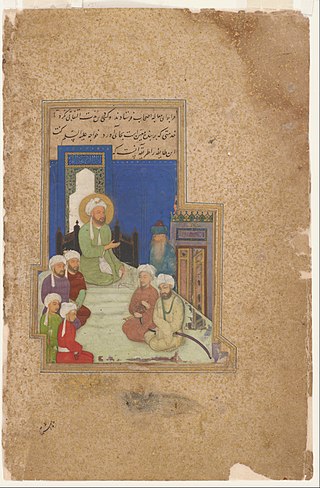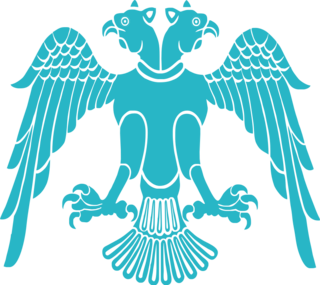See also
| | This biography related to medicine in Iran is a stub. You can help Wikipedia by expanding it. |
Sultan Ali Khorasani was a 16th-century Persian physician from Khorasan, Persia.
Sultan-‘Ali usually signed his name as Hakim Sultan-Ali Tabib Khurasani -- that is, doctor Sultan-‘Ali, physician of Khurasan (in Persia).
He practiced medicine for 40 years in Khurasan and in Transoxiana (Central Asia), especially in Samarqand. He began writing his Persian therapeutic manual Dastur al-‘ilaj in the year 1526 at the request of Abu al-Muzaffar Mahmud-Shah Sultan.
Numerous copies of his manual are preserved today.
For his treaties and the few details of his life, see:

'Ali ibn al-'Abbas al-Majusi, also known as Masoudi, or Latinized as Haly Abbas, was a Persian physician and psychologist from the Islamic Golden Age, most famous for the Kitab al-Maliki or Complete Book of the Medical Art, his textbook on medicine and psychology.
Alī ibn Aḥmad al-Nasawī was a Persian mathematician from Khurasan, Iran. He flourished under the Buwayhid sultan Majd al-dowleh, who died in 1029-30AD, and under his successor. He wrote a book on arithmetic in Persian, and then Arabic, entitled the "Satisfying on Hindu Calculation". He also wrote on Archimedes's Book of Lemmas and Menelaus's theorem, where he made corrections to the Book of Lemmas as translated into Arabic by Thabit ibn Qurra and last revised by Nasir al-Din al-Tusi.

Sultan Husayn Bayqara Mirza was the Timurid ruler of Herat from 1469 until May 4, 1506, with a brief interruption in 1470.
Hakim Ali ibn Kamal al-Din Muhammad Gilani was a 16th-century Gilak royal physician from Gilan, Iran.
Muhammad ibn Mahmud al-Amuli was a medieval Persian physician from Amol, Iran.

Ghiyāth al-Dīn ʿAlī ibn Ḥusayn ibn ʿAlī Amīrān Iṣfahānī was a fifteenth-century Persian physician and scientist from Isfahan, Iran. He was, in the words of Daniel Beben, 'a polymath in the service of several of the Timurid governors of Badakhshān in the second half of the 15th century' CE. Little is known of him beyond the works attributed to him.

Manṣūr ibn Muḥammad ibn Aḥmad ibn Yūsuf Ibn Ilyās was a late 14th century and early 15th century Persian physician from Shiraz, Timurid Persia, commonly known for his publication of the colored atlas of the human body, Mansur’s Anatomy. It is important to know that al-Jurjani (1040–1136) published a book called "Zakhireye Khwarazmshahi" which Mansur could have copied the illustrations from his book.
Maqsud Ali Tabrizi was a 17th-century Iranian physician from Tabriz.
Muhammad Akbar ibn Mir Hajji Muhammad Muqim Arzani was a physician from Persia.
Muhammad Hussayn ibn Muhammad Hadi al-‘Aqili al-‘Alavi al-Khurasani al-Shirazi was a Persian physician from the 18th century from Shiraz.
Ziya' al-Din Nakhshabi was a 14th-century Persian physician and Sufi living in India. He died in 1350.
Rostam Gorgani was a mid-16th century Persian physician who lived in India.

Anvari (1126–1189), full name Awhad ad-Din 'Ali ibn Mohammad Khavarani or Awhad ad-Din 'Ali ibn Mahmud was a Persian poet.

The Seljuk dynasty, or Seljukids, also known as Seljuk Turks, Seljuk Turkomans or the Saljuqids, was an Oghuz Turkic, Sunni Muslim dynasty that gradually became Persianate and contributed to the Turco-Persian tradition in the medieval Middle East and Central Asia. The Seljuks established the Seljuk Empire (1037–1194), the Sultanate of Kermân (1041–1186) and the Sultanate of Rum (1074–1308), which at their heights stretched from Iran to Anatolia and were the prime targets of the First Crusade.
Sultan Muhammad was the Timurid ruler of Persia and Fars from around 1447 until his death. He was the son of Baysunghur son of Shah Rukh.

The practice and study of medicine in Persia has a long and prolific history. The Iranian academic centers like Gundeshapur University were a breeding ground for the union among great scientists from different civilizations. These centers successfully followed their predecessors’ theories and greatly extended their scientific research through history. Persians were the first establishers of modern hospital system.
Husayn ibn Muhammad ibn Ali al-Astarabadi was a 15th-century Persian physician from Astarabad, Golestan, Persia.

The Tomb of Ahmad Sanjar is a mausoleum commemorating Ahmad Sanjar, a Seljuk ruler of Khorasan. It was built in 1157 in the medieval city of Merv in the Karakum Desert in Turkmenistan. Throughout his reign, Sanjar fought off several invasions and uprisings until finally being defeated by the Oghuz. After being sacked by the Oghuz, Merv declined and in 1221, the Mongols attacked it and burned down the mausoleum. It would later be restored by Soviet, Turkmen, and Turkish architects during the 20th and 21st centuries. The tomb is part of The State Historical and Cultural Park "Ancient Merv", a UNESCO World Heritage Site.
Abul-Qasim Babur Mirza, was a Timurid ruler in Khurasan (1449–1457). He was the son of Ghiyath-ud-din Baysunghur ibn Shah Rukh Mirza, and thus a great-grandson of Amir Timur.
Ghiyath ad-Dunya wa ad-Din ibn Muhammad, better known by his regnal name of Suleiman-Shah, was sultan of the Seljuq Empire from 1159 to 1160.